Customizing Puffin
Our 4X is number 44 in the production series. That doesn’t mean that Outremer have made 44, 4X boats, but rather the 4X shares the production numbers with the 45. The 4X is identical in most ways to the 45, and they both use the same molds. The 4X uses more carbon fiber, has a modified sailplan, has some weight saving changes to the interior, and has a different standard options package, but aside from that it’s the same as a 45. In any case, it’s good to know that Outremer have had 43 previous boats to practice on, so they can build us a perfect 4X number 44 🙂
The 4X is a well-designed and complete boat, with many of the options required for offshore cruising included in the standard package. That gave us a good starting point, but there were still some things that we wanted to add and change to better optimize the boat for our needs.
Some of the design decisions are standard for any new boat, such as choosing among the available color options, interior surfaces and layout choices. These are pretty quick and easy to work out. Other decisions such as selecting sails, electronics, instruments, communications and safety equipment are more complicated because there are new products and changes to existing products being released all the time that need to be researched. In addition to the standard design choices, there were some modifications I wanted to make that Outremer had not done before on a 4X, so a solution needed to be developed by the Outremer engineering team.
Major Items
On the list of more complex adds and changes are:
- Options for reducing the overall weight of the boat
- Sailplan design and sail selection to give us maximum performance with minimum weight, along with the flexibility to match the sail area and configuration to a wide range of wind and sea conditions
- Sail handling optimizations to make it easier to sail single handed
- Electric power and battery charging systems design, to give us adequate power to operate all of our onboard systems and keep the batteries charged with a minimum use of fossil fuels
- Liveaboard cruising features to set the boat up for how we like to live on passage and at anchor
I’ll go through all of the major items above in detail in future posts. In the rest of this post I will go over the 4X standard features which we kept and some of the minor things we added and changed. This is not an exhaustive list, I’m just going to focus on the more significant features on the boat:
Saloon
The 4X saloon is an excellent design. I think the saloon and cockpit design of all the Outremer boats really sets them apart from the other catamarans I have seen. The 4X saloon is a scaled down version of the 5X, which we loved, so no changes needed. Blinds and mosquito screens on all the hatches are standard, which is an important feature.
We added:
- Caframo ventilation fans – We had air conditioning on Wildling, but we can’t afford the weight on Puffin, so we will have ventilation fans instead. We hardly ever used the air conditioning on Wildling, so it wasn’t a big sacrifice to do without.
- Extra USB charging points
- Removable, external shade screens on the salon windows, same as we had on Wildling
- We had the saloon table that can be lowered and converted to a bed on the 5X and used it all the time, so we ordered that for Puffin also
Galley
The standard 4X galley is very good, so no changes needed to the work surfaces, sink, oven or stove top.
We added:
- A freezer under the port side aft counter. We kept the standard fridge on the starboard side. Having just a fridge with a tiny freezer compartment isn’t enough when passage-making.
- A Seagull Nature Pure water filter and tap at the sink so we can drink filtered tank water and not have any plastic water bottles aboard.
- A bio waste tube on the counter beside the sink to drop foodscraps overboard when doing dishes underway
- A seawater tap at the sink to save freshwater when rinsing dishes. We also added an expansion tank to the seawater pump. This reduces the amount of rapid on/off switching of the pump when opening and closing the tap, which extends the life of the pump and pressure switch.
- A 12V, 100 liter/hr Dessalator watermaker
Navigation Station / Chart Table
The nav station is pretty much identical to the 5X. A very important feature on any boat, as we spend so much time there when on passage, and particularly during night watches. I find too many boats overlook the design of the nav station, and I don’t understand why. We loved our 5X nav station so we’re not making any changes on our 4X.
Here’s a diagram of how the instrument layout will look.
Starboard (owner’s) Hull
The starboard side is the owner’s suite in the 4X. It’s a good layout and feels very spacious, with a queen size bunk aft and plenty of room for storage. There are no solid interior doors on the 4X to save weight, instead there are zipper fabric dividers for the bathrooms.
We added:
- Electric flush toilets – don’t leave the dock without these, they are awesome! Easy to use by sailors and land-lubbers alike, and in our experience after 3 years on Wildling, not a single problem, ever!
- A Sea water supply valve to the toilets that can be selected when offshore to save fresh water
- Fans in the aft bunk and also in the bathroom (Robin always wished we had a bathroom fan in Wildling)
- A privacy curtain to close off the aft bunk, so guests can share the master bathroom and shower without disturbing the poor old, tired, off-watch skipper!
Port (guest) Hull
The port side has an aft queen bunk and a single bunk forward, with a shared bathroom in the middle. To reduce weight, there are zipper fabric dividers instead of solid doors for privacy in the guest cabins and bathroom.
We added:
- Electric flush toilets same as starboard side with sea water supply valve
- Fans in the cabins
- An extra bunk bed in the forward cabin so we can sleep two single quests – This adds weight “OUCH” (the bunk not the guests, Robin tells me it’s impolite to weigh the guests as the come onboard) but we found some ways to compensate with our weight saving design changes.

Cockpit
No changes needed to the standard cockpit design. The 4X uses two removable fabric canopy panels on each side of the cockpit bimini roof. We had a full solid roof on the 5X, and I was concerned that the fabric panels would leave the cockpit too exposed to the sun when they are removed when underway, but after seeing them at the factory, I realized this is a clever design. Being able to remove them is a great visibility aid when maneuvering in port and reduces windage in a storm. If it’s too windy to have the panels up underway, we would most likely be inside anyway. Also, when the panels are up it makes the cockpit feel bigger and more airy than a full solid bimini roof, not to mention the weight saved versus a solid roof. This was a case of needing to see it in person to understand the benefits of the design.
Helm Station
No changes to the basic helm station design, but a few optimizations:
We added:
- Remote control for the anchor windlass at the helm
- Some changes to the sail handling setup to facilitate single-handed operation. More on this in an upcoming post
- The helm seats beside the carbon tillers on each side of the boat are really great. We had white plastic versions of these on Wildling and we used them constantly. My favorite place at night to watch the stars and the waves slip by! The problem I had with the 4X seats is that the standard carbon seats are black and would get way too hot in the Australian sun, so we exchanged them for the basic white plastic seats. Not much of a weight difference, fortunately.
Engines & Drives
Nothing to change on the engines, two little 30 hp D-1 Volvos are standard. I’ve never owned anything but Volvo in my boats, so can’t say if they are better or worse than the alternatives. The important point is I know how to fix them, and Outremer uses them exclusively, so they know how to set them up and they provide good after sales support.
The 4X standard configuration is saildrives with folding Volvo props. We discussed using shaft drives instead to save weight and move the engine weight further forward to minimize pitching. This is theoretically the best design, but it would have required a lot of changes to the interior layout, so we decided it wasn’t worth it. I’m compensating by choosing an ultra-light carbon dinghy with electric outboard to keep weight out of the back end of the boat.
Mooring & Safety
The mooring setup is pretty much up to the owner to decide, so I will list what we chose below. The standard safety equipment is very complete, so there were only a few items needed.
We added:
- A Liferaft mounted at the port aft end of the trampoline (standard location)
- An EPIRB mounted in the salon
- Anchor – We chose a 27 kg Ultra anchor. We have cruised extensively with Spade, CQR, Rocna and Ultra anchors. The CQR was worthless and dragged constantly. The others were all excellent. I chose the Ultra because I don’t think the Rocna will fit on the 4X davits, and the Ultra sets better than the Spade on a short scope. I’ve used a Spade and an Ultra in the same anchorages on different occasions and the Ultra would reliably set at 3:1 scope where the Spade required 4:1. This is an advantage in light wind, crowded anchorages where putting out more scope increases the risk of swinging into another boat. (Increasing scope as the wind builds to improve holding, is of course required for all anchors).
- 50m of G7 chain + 50m nylon rode – this is a smaller, high strength chain size to save weight. We had to also select a different size windlass gypsy to fit the G7 chain
- We chose lightweight inflatable fabric fenders. There is a tradeoff with using these fenders. The light weight is really good for handling them and saving weight when on passage, but they are at times too light when at the dock, because they get blown around by the wind, leaving the boat sides unprotected. We used to put some water in ours on Wildling to weigh them down when we are at a marina for more than a few days, or if it gets windy
That’s about it for the standard options and additions on Puffin. In the next post I’ll go over the details of how we took an already lightweight boat and made it even lighter!
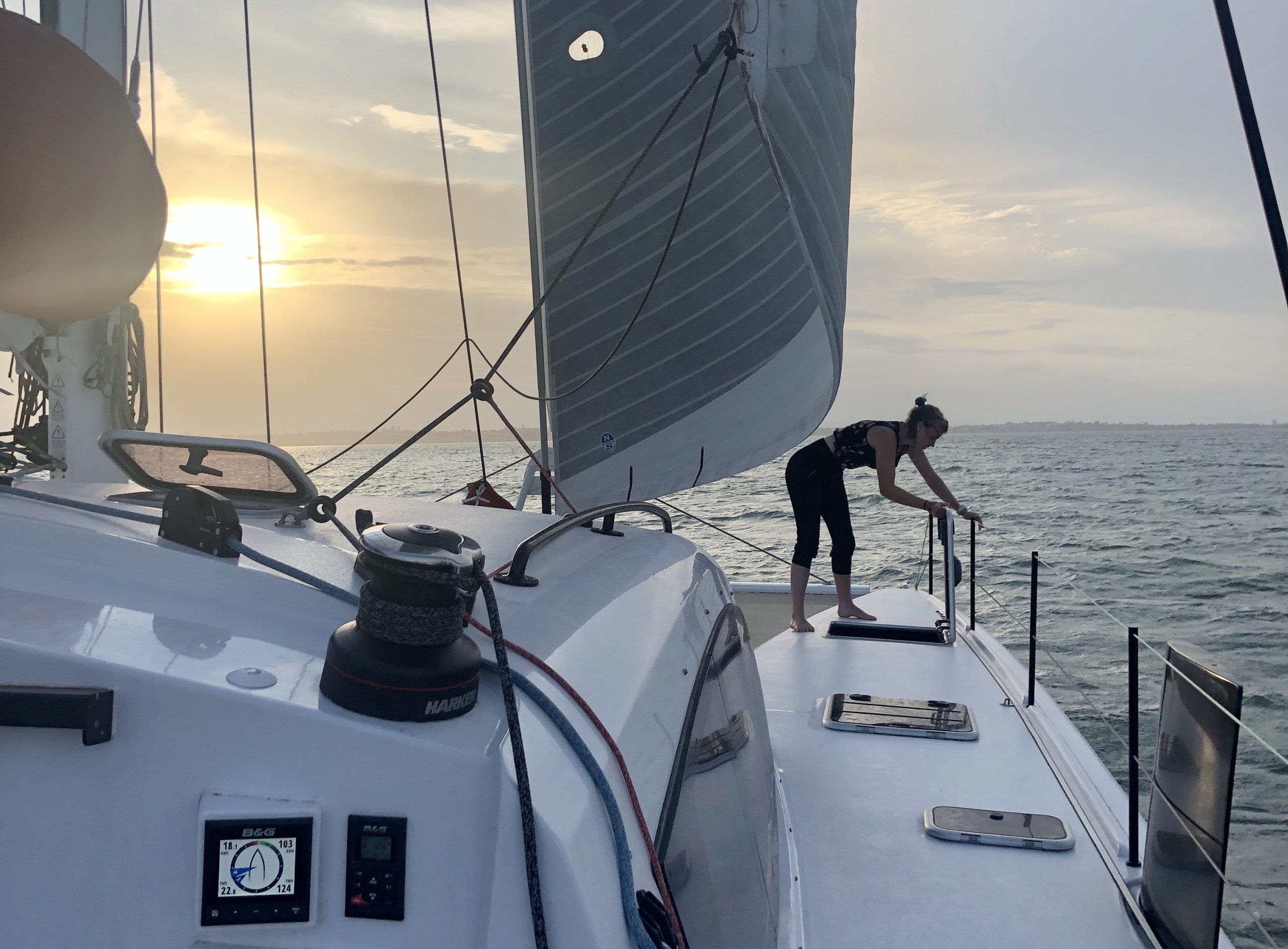

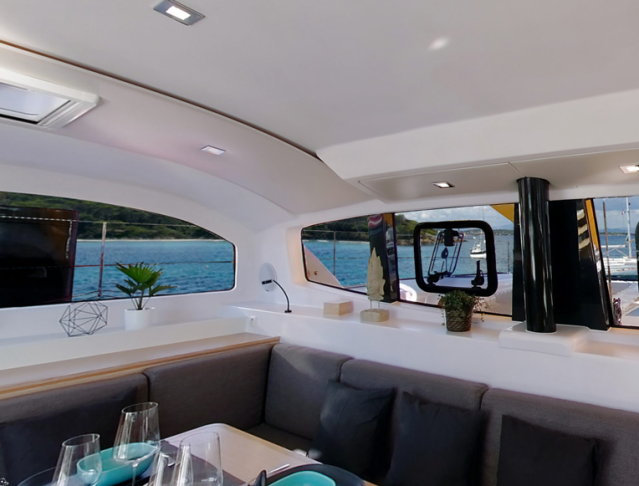
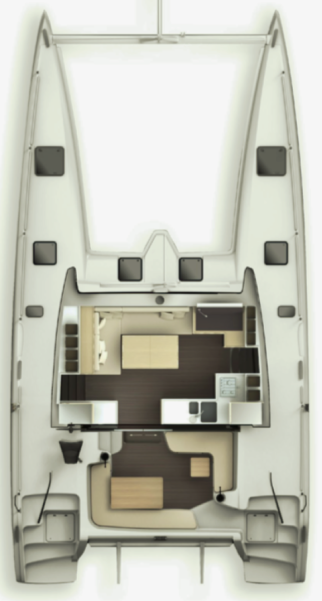
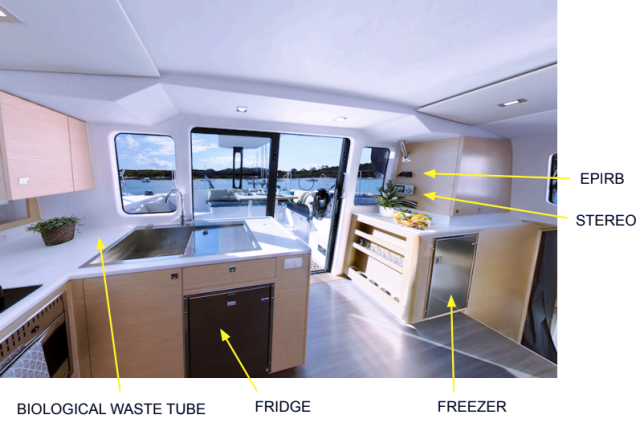


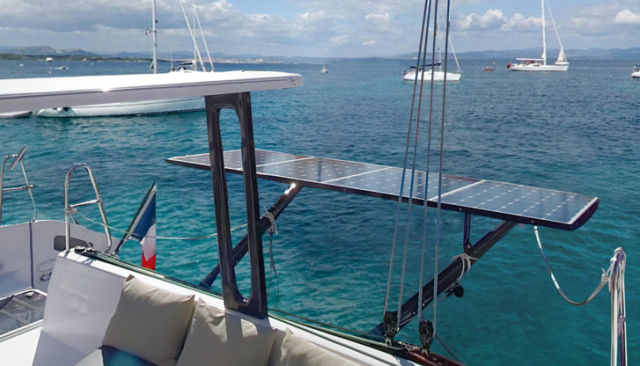

Hello Doug,
as always, very interesting blog entry. We have been following your 5X blog and made changes to our boat based on your experience.
Will you address the sail plan in a different blog? I am wondering if you will chose a genoa and staysail or a jib only. We have a NS 3Di genoa, with a large roach, it is almost not possible to reef the sail without wrinkles. Therefore we added a staysail on a furler on the inner forestay for wind ≥ 22kts.
Our mainsail is eight years old, the sailmaker recommends a four reef sail. Any thoughts on that? Also, we just added a one-line reefing line for the first two reefs. Any feedback?
Do you have plans for a Code Zero, Code D or symmetrical spinnaker?
Also, I noticed on your instrument panel you have chosen MasterVolt equipment. We have replaced the MasterVolt devices with a Victron inverter, battery & solar charger, the BVM battery monitor and the Color Control GX display. Fantastic remote access, even allows geofencing with a $29 GPS, excellent mobile phone / tablet access. It seems you do a lot of research, again … ‘looking forward to your input.
Thanks, Tom
LikeLike
Hi Tom,
Yes, I did a lot of work on the sail selections and sailplan. I will cover it in detail soon in an upcoming post. I have always used Mastervolt and had very good experience, also Outremer standardizes on Mastervolt on their boats whenever possible, so I didn’t have a reason to change. Nothing against Victron though, their gear is excellent.
Cheers
LikeLike
Hi Doug, just wanted to share with you that your previous blog was very helpful and a major factor in our decision to buy a 4X ourselves. So thank you. Ironically we beat you to that, although just barely, as we have hull #43 “Lynx”.
Keep up the good work and updates.💪🏻
Pietro
LikeLike
Doug, why have you chose to go without skegs to protect the sail drive?
Stuart
LikeLike
Outremer has stopped installing sacrificial skegs, as they had too much trouble with them falling off under lateral pressure. It’s also debatable as to how much value they provide on a daggerboard cat. I don’t have a strong opinion either way, so I deferred to Outremer’s decision on this.
LikeLike
Hi Doug Outremer were happy to include for my 4x. I did read your Wildling issues. I will check this out with the factory.
LikeLike
Hi, for your G7 anchor chain, is this 8mm? If so a great choice as more is not really needed, chain weights can be added for greater cantenary.
LikeLike
Hi Kev, yes 8mm chain. It’s working great for us, holding strong in 30+ knots and we have not dragged in any anchoring situation so far.
LikeLike